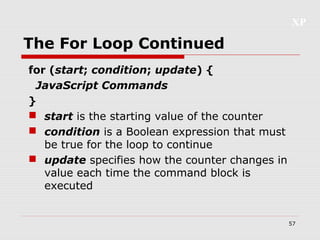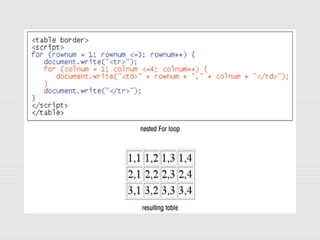Java script
- 1. XP 1 JavaScript Creating a Programmable Web Page
- 2. XP 2 Tutorial Objectives Understand basic JavaScript syntax Create an embedded and external script Work with variables and data Work with data objects and extract values from dates Work with expressions and operators Create and call a JavaScript function Work with arrays and conditional statements Learn about program loops
- 3. XP 3 Server-Side Programs a user must be connected to the Web server to run the server-side script only the programmer can create or alter the script the system administrator has to be concerned about users continually accessing the server and potentially overloading the system
- 4. XP 4 Client-Side Programs solve many of the problems associated with server-side scripts can be tested locally without first uploading it to a Web server are likely to be more responsive to the user can never completely replace server-side scripts
- 5. XP 5 Introduction to JavaScript JavaScript is an interpreted programming or script language from Netscape. JavaScript is used in Web site development to such things as: automatically change a formatted date on a Web page cause a linked-to-page to appear in a popup window cause text or a graphic image to change during a mouse rollover
- 6. XP 6 Java vs. JavaScript Requires the JDK to create the applet Requires a Java virtual machine to run the applet Applet files are distinct from the XHTML code Source code is hidden from the user Programs must be saved as separate files and compiled before they can be run Programs run on the server side Requires a text editor Required a browser that can interpret JavaScript code JavaScript can be placed within HTML and XHTML Source code is made accessible to the user Programs cannot write content to the hard disk Programs run on the client side
- 7. XP 7 ECMAScript The responsibility for the development of a scripting standard has been transferred to an international body called the European Computer Manufacturers Association (ECMA). The standard developed by the ECMA is called ECMAScript, though browsers still refer to it as JavaScript. The latest version is ECMA-262, which is supported by the major browsers.
- 8. XP 8 Other Client-side Languages Internet Explorer supports JScript. JScript is identical to JavaScript, but there are some JavaScript commands not supported in JScript, and vice versa. Other client-side programming languages are also available to Web page designers, such as the Internet Explorer scripting language, VBScript.
- 9. XP 9 Example of Web Site using JavaScript
- 10. XP 10 Writing a JavaScript Program The Web browser runs a JavaScript program when the Web page is first loaded, or in response to an event. JavaScript programs can either be placed directly into the HTML file or they can be saved in external files. placing a program in an external file allows you to hide the program code from the user source code placed directly in the HTML file can be viewed by anyone
- 11. XP 11 Writing a JavaScript Program A JavaScript program can be placed anywhere within the HTML file. Many programmers favor placing their programs between <head> tags in order to separate the programming code from the Web page content and layout. Some programmers prefer placing programs within the body of the Web page at the location where the program output is generated and displayed.
- 12. XP 12 Using the <script> Tag To embed a client-side script in a Web page, use the element: <script type=“text/javascript” > script commands and comments </script> To access an external script, use: <script src=“url” type=“text/javascript”> script commands and comments </script>
- 13. XP 13 Comments The syntax for a single-line comment is: // comment text The syntax of a multi-line comment is: /* comment text covering several lines */
- 14. XP 14 Hiding Script from Older Browsers You can hide the script from these browsers using comment tags: <script type=“text/javascript”> <!-- Hide from non-JavaScript browsers JavaScript commands // Stop hiding from older browsers --> </script> When a Web browser that doesn’t support scripts encounters this code, it ignores the <script> tag.
- 15. XP 15 Writing Output to a Web Page JavaScript provides two methods to write text to a Web page: document.write(“text”); document.writeln(“text”); The document.writeln() method differs from document.write() in that it attaches a carriage return to the end of each text string sent to the Web page. document.write("<h3>News Flash!</h3><br />");
- 16. XP 16 JavaScript Syntax Issues JavaScript commands and names are case- sensitive. JavaScript command lines end with a semicolon to separate it from the next command line in the program. in some situations, the semicolon is optional semicolons are useful to make your code easier to follow and interpret
- 17. XP 17 Working with Variables & Data A variable is a named element in a program that stores information. The following restrictions apply to variable names: the first character must be either a letter or an underscore character ( _ ) the remaining characters can be letters, numbers, or underscore characters variable names cannot contain spaces Variable names are case-sensitive. document.write(Year);
- 18. XP 18 Types of Variables JavaScript supports four different types of variables: numeric variables can be a number, such as 13, 22.5, or -3.14159 string variables is any group of characters, such as “Hello” or “Happy Holidays!” Boolean variables are variables that accept one of two values, either true or false null variables is a variable that has no value at all
- 19. XP 19 Declaring a Variable Before you can use a variable in your program, you need to declare a variable using the var command or by assigning the variable a value. Any of the following commands is a legitimate way of creating a variable named “Month”: var Month; var Month = “December”; Month = “December”;
- 20. XP 20 Working with Dates There are two ways to create a date object: variable = new Date(“month day, year, hours:minutes: seconds”) variable = new Date(year, month, day, hours, minutes, seconds”) variable is the name of the variable that contains the date information month, day, year, hours, minutes, and seconds indicate the date and time var Today=new Date(“October 15, 2006”); var Today=new Date(2006, 9, 15);
- 21. XP 21 Retrieving the Day & Time Values JavaScript stores dates and times as the number of milliseconds since 6 p.m on 12/31/69. Use built in JavaScript date methods to do calculations. If you want the ThisDay variable to store the day of the month. To get that information, apply the getDate() method. DayValue = DateObject.getDate()
- 22. XP 22 Retrieving the Month Value The getMonth() method extracts the value of the current month. JavaScript starts counting months with 0 for January, you may want to add 1 to the month number returned by the getMonth() method. ThisMonth = Today.getMonth()+1;
- 23. XP 23 Retrieving the Year Value The getFullYear() method extracts the year value from the date variable. ThisYear = Today.getFullYear();
- 24. XP 24 Working with Expressions and Operators Expressions are JavaScript commands that assign values to variables. Expressions are created using variables, values, and operators. The + operator performs the action of adding or combining two elements. For example, var ThisMonth = Today.getMonth()+1;
- 26. XP 26 Operators Binary operators work on two elements in an expression. Unary operators work on only one variable. unary operators include: the increment (+ +), decrement (--), and negation (-) operators. An increment operator is used to increase the value of the x variable by one. x = 100; y = x++;
- 27. XP 27 Operators The decrement operator reduces the value of a variable by 1. x = 100; y = x--; The negation operator changes the sign of a variable: x = -100; y = -x;
- 28. XP 28 Assignment Operators Expressions assign values using assignment operators. “=” is the most common one. Additional includes the += operator The following create the same results: x = x + y; x += y Either of the following increase the value of the x variable by 2: x = x + 2; x += 2
- 30. XP 30 The Math Object & Math Methods Another way of performing a calculation is to use the JavaScript built-in Math methods. These methods are applied to an object called the Math object. The syntax for applying a Math method is: value = Math.method(variable); For example, AbsValue = Math.abs(NumVar);
- 32. XP 32 Creating JavaScript Functions function function_name(parameters) { JavaScript commands } parameters are the values sent to the function (note: not all functions require parameters) { and } are used to mark the beginning and end of the commands in the function.
- 33. XP 33 Creating JavaScript Functions Function names are case-sensitive. The function name must begin with a letter or underscore ( _ ) and cannot contain any spaces. There is no limit to the number of function parameters that a function may contain. The parameters must be placed within parentheses, following the function name, and the parameters must be separated by commas.
- 34. XP 34 Performing an Action with a Function The following function displays a message with the current date: function ShowDate(date) { document.write(“Today is” + date + “<br>”); } there is one line in the function’s command block, which displays the current date along with a text string
- 35. XP 35 Performing an Action with a Function To call the ShowDate function, enter: var Today = “3/9/2006”; ShowDate(Today); the first command creates a variable named “Today” and assigns it the text string, “3/9/2006” the second command runs the ShowDate function, using the value of the Today variable as a parameter result is “Today is 3/9/2006”
- 36. XP 36 Returning a Value from a Function To use a function to calculate a value use the return command along with a variable or value. function Area(Width, Length) { var Size = Width*Length; return Size; } the Area function calculates the area of a rectangular region and places the value in a variable named “Size” the value of the Size variable is returned by the function
- 37. XP 37 Placing a Function in an HTML File The function definition must be placed before the command that calls the function. One convention is to place all of the function definitions in the <head> section. A function is executed only when called by another JavaScript command. It’s common practice for JavaScript programmers to create libraries of functions located in external files.
- 38. document.write("Today is "+ThisMonth+"/"+ ThisDay+"/"+ThisYear+"<br />"); document.write("Only "+DaysLeft+ " days until Christmas");
- 39. <head> <script src="library.js" type="text/javascript"> </script> </head> <script type="text/javascript"> var Today=new Date("October 15, 2006"); var ThisDay=Today.getDate(); var ThisMonth=Today.getMonth()+1; var ThisYear=Today.getFullYear(); var DaysLeft=XmasDays(Today); </script> document.write("Today is "+ThisMonth+"/"+ ThisDay+"/"+ThisYear+"<br />"); document.write("Only "+DaysLeft+ " days until Christmas");
- 40. function XmasDays(CheckDay) { var XYear=CheckDay.getFullYear(); var XDay=new Date("December, 25, 2006"); XDay.setFullYear(XYear); var DayCount=(XDay-CheckDay) /(1000*60*60*24); DayCount=Math.round(DayCount); return DayCount; } library.js
- 41. XP 41 Setting Date Values JavaScript functions that allow you to set or change the values of date objects
- 42. XP 42 Working with Conditional Statements if (condition) { JavaScript Commands } condition is an expression that is either true or false if the condition is true, the JavaScript Commands in the command block are executed if the condition is not true, then no action is taken
- 43. XP 43 Comparison, Logical, and Conditional Operators To create a condition, you need one of three types of operators: a comparison operator compares the value of one element with that of another, which creates a Boolean expression that is either true or false a logical operator connects two or more Boolean expressions a conditional operator tests whether a specific condition is true and returns one value if the condition is true and a different value if the condition is false
- 44. XP 44 An Example of Boolean Expressions x < 100; if x is less than 100, this expression returns the value true; however, if x is 100 or greater, the expression is false y == 20; the y variable must have an exact value of 20 for the expression to be true comparison operator uses a double equal sign (==)
- 46. XP 46 A Logical Operator The logical operator && returns a value of true only if all of the Boolean expressions are true.
- 47. XP 47 A Conditional Operator tests whether a specific condition is true and returns one value if the condition is true and a different value if the condition is false. Message = (mail == “Yes”) ? “You have mail”: “No mail”; tests whether the mail variable is equal to the value “Yes” if it is, the Message variable has the value “You have mail”; otherwise, the Message variable has the value “No mail”.
- 48. XP 48 Using an If...Else Statement if (condition) { JavaScript Commands if true } else JavaScript Commands if false } condition is an expression that is either true or false, and one set of commands is run if the expression is true, and another is run if the expression is false
- 49. document.write("Today is " + ThisMonth + "/“+ThisDay+"/"+ThisYear+"<br />"); if (DaysLeft > 0) { document.write("Only "+DaysLeft+ " days until Christmas"); } else { document.write("Happy Holidays from Nroth Pole Novelties"); } if...else Conditional Statement
- 50. XP 50 Using Arrays An array is an ordered collection of values referenced by a single variable name. The syntax for creating an array variable is: var variable = new Array(size); variable is the name of the array variable size is the number of elements in the array (optional) To populate the array with values, use: variable[i]=value; where i is the ith item of the array. The 1st item has an index value of 0.
- 51. XP 51 Using Arrays To create and populate the array in a single statement, use: var variable = new Array(values); values are the array elements enclosed in quotes and separated by commas var MonthTxt=new Array(“”, “January”, “February”, “March”, “April”, “May”, “June”, “July”, “August”, “September”, “October”, “November”, “December”); January will have an index value of “1”.
- 52. <script type="text/javascript"> var Today=new Date(); var ThisDay=Today.getDate(); var ThisMonth=Today.getMonth()+1; var ThisYear=Today.getFullYear(); var DaysLeft=XmasDays(Today); var MonthTxt = new Array("", "January", "February", "March", "April", "May", "June", "July", "August", "September", "October","November", "December"); document.write("Today is "+MonthTxt[ThisMonth]+" " + ThisDay+", "+ThisYear+"<br />"); if (DaysLeft > 0) { document.write("Only "+DaysLeft+" days until Christmas"); } else { document.write("Happy Holidays from North Pole Novelties"); } </script>
- 53. function MonthTxt(MonthNumber) { var Month=new Array(); Month[0]=""; Month[1]="January"; Month[2]="February"; Month[3]="March"; Month[4]="April"; Month[5]="May"; Month[6]="June"; Month[7]="July"; Month[8]="August"; Month[9]="September"; Month[10]="October"; Month[11]="November"; Month[12]="December"; return Month[MonthNumber]; } Creating the MonthText Function in library2.js
- 54. <head> <script src="library2.js" type="text/javascript"></script> </head> var MonthName=MonthTxt(ThisMonth); Calling the MonthTxt Function use the ThisMonth variable to call the MonthTxt function and then stores the result in a new variable named “MonthName”
- 55. XP 55 Working with Program Loops A program loop is a set of instructions that is executed repeatedly. There are two types of loops: loops that repeat a set number of times before quitting loops that repeat as long as a certain condition is met
- 56. XP 56 The For Loop The For loop allows you to create a group of commands to be executed a set number of times through the use of a counter that tracks the number of times the command block has been run. Set an initial value for the counter, and each time the command block is executed, the counter changes in value. When the counter reaches a value above or below a certain stopping value, the loop ends.
- 57. XP 57 The For Loop Continued for (start; condition; update) { JavaScript Commands } start is the starting value of the counter condition is a Boolean expression that must be true for the loop to continue update specifies how the counter changes in value each time the command block is executed
- 60. Specifying Counter Values in a For Loop
- 61. XP 61 The While Loop The While loop runs a command group as long as a specific condition is met, but it does not employ any counters. The general syntax of the While loop is: while (condition) { JavaScript Commands } condition is a Boolean expression that can be either true or false

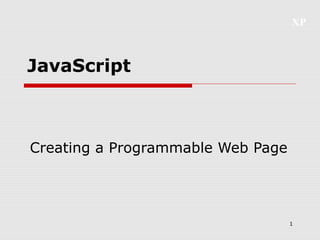



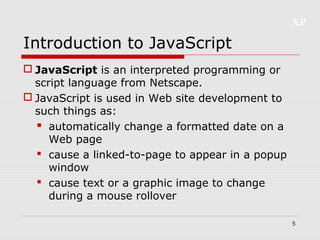
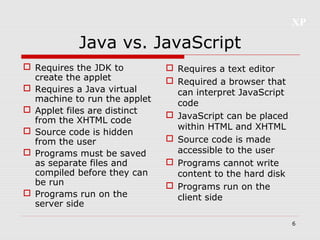


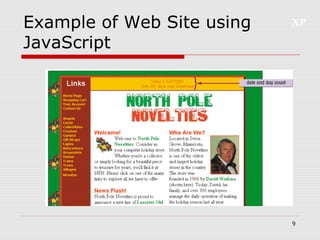

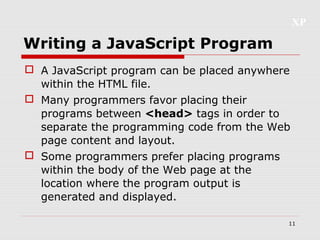
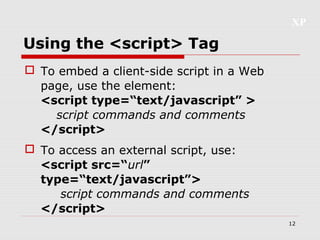

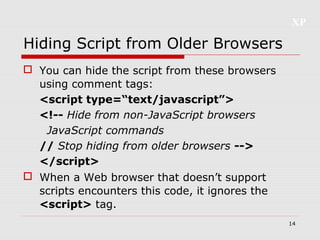
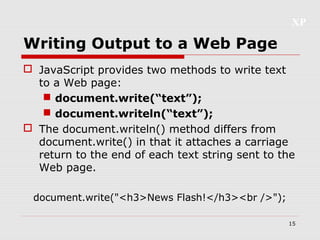
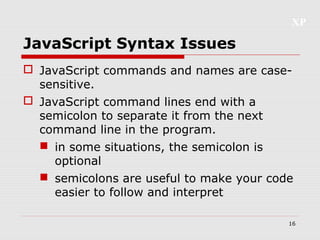
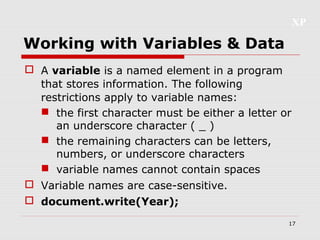
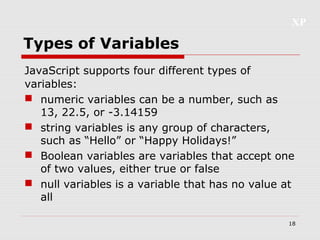
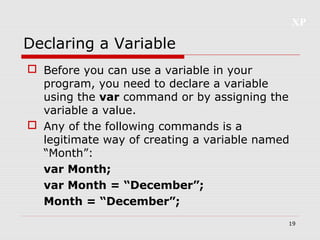
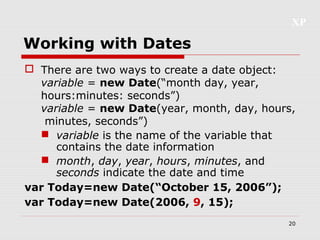
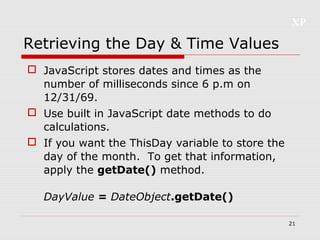
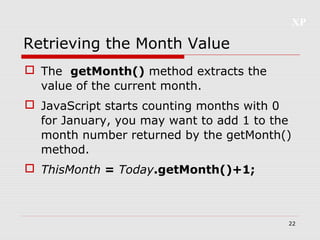
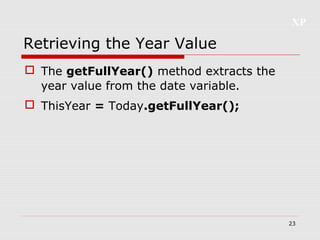
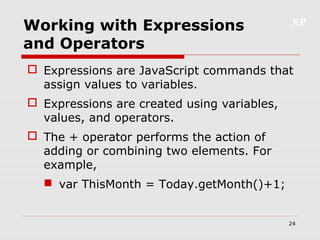


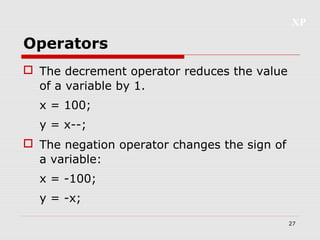
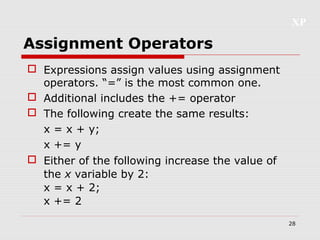

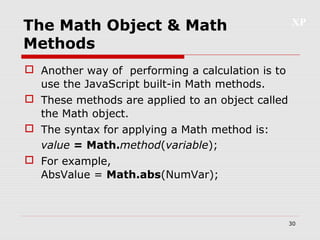

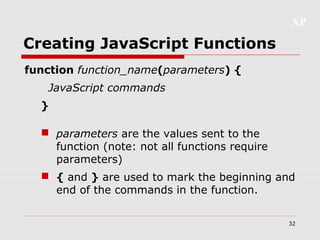

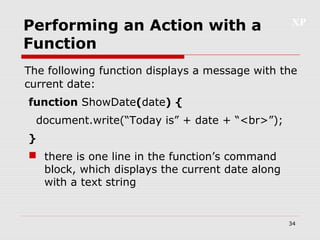





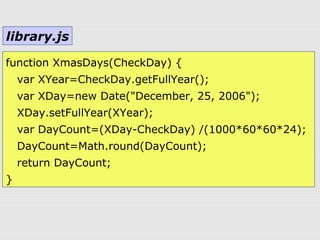
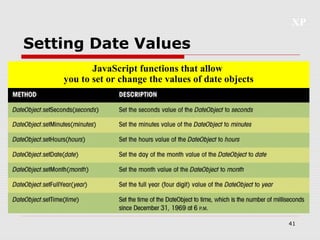
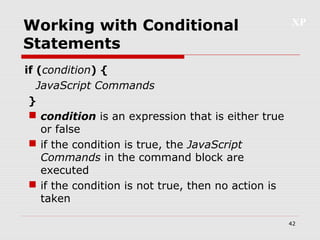

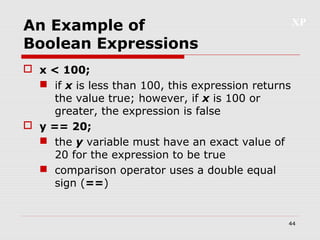
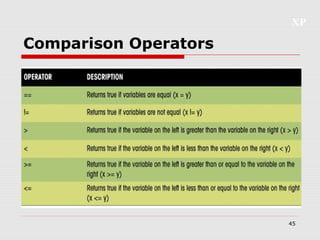

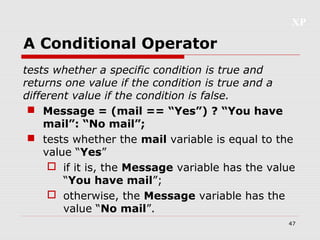
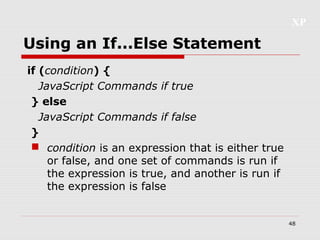
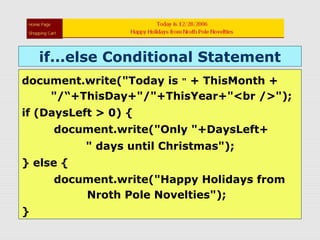
![XP
50
Using Arrays
An array is an ordered collection of values
referenced by a single variable name.
The syntax for creating an array variable is:
var variable = new Array(size);
variable is the name of the array variable
size is the number of elements in the array
(optional)
To populate the array with values, use:
variable[i]=value;
where i is the ith
item of the array. The 1st
item
has an index value of 0.](https://image.slidesharecdn.com/javascript-130804170611-phpapp02/85/Java-script-50-320.jpg)

![<script type="text/javascript">
var Today=new Date();
var ThisDay=Today.getDate();
var ThisMonth=Today.getMonth()+1;
var ThisYear=Today.getFullYear();
var DaysLeft=XmasDays(Today);
var MonthTxt = new Array("", "January", "February", "March",
"April", "May", "June", "July", "August", "September",
"October","November", "December");
document.write("Today is "+MonthTxt[ThisMonth]+" " +
ThisDay+", "+ThisYear+"<br />");
if (DaysLeft > 0) {
document.write("Only "+DaysLeft+" days until Christmas");
} else {
document.write("Happy Holidays from North Pole
Novelties");
}
</script>](https://image.slidesharecdn.com/javascript-130804170611-phpapp02/85/Java-script-52-320.jpg)
![function MonthTxt(MonthNumber) {
var Month=new Array();
Month[0]="";
Month[1]="January";
Month[2]="February";
Month[3]="March";
Month[4]="April";
Month[5]="May";
Month[6]="June";
Month[7]="July";
Month[8]="August";
Month[9]="September";
Month[10]="October";
Month[11]="November";
Month[12]="December";
return Month[MonthNumber];
}
Creating the MonthText Function in library2.js](https://image.slidesharecdn.com/javascript-130804170611-phpapp02/85/Java-script-53-320.jpg)



